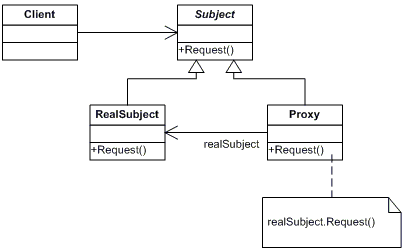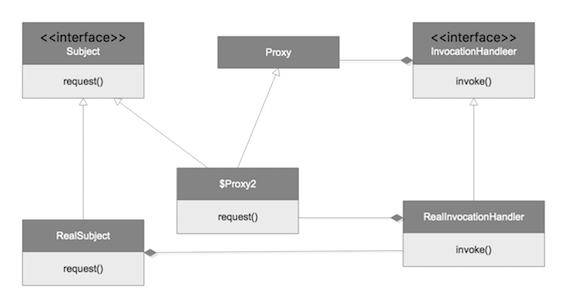代理模式
代理模式
为其他对象提供一中代理以控制对这个对象的访问
类图

- Proxy
- 保存一个引用是的代理可以访问实体,若RealSubject和Subject的接口相同,Proxy会引用Subject
- 提供一个与Subject的接口相同的接口,这样代理就可以用来替换实体
- 控制对实体的存取,并可能负责创建和删除它
- 其他功能依赖于代理的类型
- Remote Proxy负责对请求及其参数进行编码,并向不同地址空间中的实体发送已编码的请求
- Virtual Proxy可以缓存实体的附加信息,以便延迟对它的访问。
- Protection Proxy 检查调用者是否具有实现一个请求所必须的访问权限。
- Subject
- 定义RealSubject和Proxy的公用接口,这样就在任何使用RealSubject的地方都可以使用Proxy
- RealSubject
- 定义Proxy所代表的实体
优缺点
- Proxy模式在访问对象时引入了一定程序的间接性,根据代理的类型,附加的间接性有多种用途:
- Remote Proxy可以隐藏一个对象存在于不同地址空间的事实
- Virtual Proxy可以进行最优化,例如根据要求创建对象
- Protection Proxies和Smart Reference都允许在访问一个对象时有一些附加的内务处理
实例
- 动态代理 Proxy#newProxyInstance(spring用的太多了)
- aop
动态代理
jdk动态代理
interface Booker {
void book();
}
class TripTicketBooker implements Booker {
@Override
public void book() {
System.out.println("book a trip ticket");
}
}
class TransactionalInvocationHandler implements InvocationHandler {
private Object target;
TransactionalInvocationHandler(Object target) {
this.target = target;
}
@Override
public Object invoke(Object proxy, Method method, Object[] args) throws Throwable {
System.out.println("begin transaction");
Object object = method.invoke(target, args);
System.out.println("end transaction");
return object;
}
}
public class JdkDynamicProxyTest {
@Test
public void dynamicProxyTest() throws InterruptedException {
// 下边这行代码是保存动态生成的类,我这不知怎么的不好使
// 我下边是通过debug,然后把动态生成的类信息对应的byte数组自己alt + f8动态运行搞到文件里的。
// System.getProperties().put("sun.misc.ProxyGenerator.saveGeneratedFiles", "true");
Booker booker = new TripTicketBooker();
Class clazz = booker.getClass();
Booker bookerProxy = (Booker) Proxy.newProxyInstance(clazz.getClassLoader(),
clazz.getInterfaces(), new TransactionalInvocationHandler(booker));
bookerProxy.book();
}
}
- 生成的代理类
bookerProxy实现了Booker接口,继承自Proxy类 Proxy类含有一个InvocationHandler的属性,我们代码中InvocationHandler的实现为TransactionInvocationHandler- bookerProxy实现的Booker接口中的book方法,实际上是通过调用TransactionInvocationHandler的invoke方法实现的。
创建代理对象
首先看下Proxy.newProxyInstance方法签名:
public static Object newProxyInstance(ClassLoader loader, Class<?>[] interfaces, InvocationHandler h)
-
loader: the class loader to define the proxy class。 define代理类的类加载器
-
interfaces: the list of interfaces for the proxy class to implement。代理类要实现的接口们
-
h: the invocation handler to dispatch method invocations to。调用处理器
-
return: a proxy instance with the specified invocation handler of a proxy class that is defined by the specified class loader and that implements the specified interfaces。返回一个由指定的类加载器defined的、实现了指定接口的、具有指定调用处理器的代理类的实例(我英语学得不好)。
然后我们跟一下newProxyInstance方法,看下它是如何生成代理类的。只说关键方法Proxy$ProxyClassFactory.apply,其他的可以看下下边的线程栈。
java.lang.Thread.State: RUNNABLE
at java.lang.reflect.Proxy$ProxyClassFactory.apply(Proxy.java:569)
at java.lang.reflect.Proxy$ProxyClassFactory.apply(Proxy.java:557)
at java.lang.reflect.WeakCache$Factory.get(WeakCache.java:230)
- locked <0x31a> (a java.lang.reflect.WeakCache$Factory)
at java.lang.reflect.WeakCache.get(WeakCache.java:127)
at java.lang.reflect.Proxy.getProxyClass0(Proxy.java:419)
at java.lang.reflect.Proxy.newProxyInstance(Proxy.java:719)
at jdk.proxy.BookerProxy.bind(DynamicProxyTest.java:43)
at jdk.proxy.DynamicProxyTest.dynamicProxyTest(DynamicProxyTest.java:60)
Proxy$ProxyClassFactory.apply
方法里会做这些事情:
- 校验传入的classLoader确实可以load传入的interfaces
- 校验传入的interfaces确实是interface
- 校验传入的interfaces中没有重复
- 校验是否含有不同包中的非public的接口
- 拼接代理类类名
- 生成代理类
下为代码(代码没动,格式有调整):
private static final class ProxyClassFactory
implements BiFunction<ClassLoader, Class<?>[], Class<?>>
{
// jdk.proxy.$Proxy2 或者 com.sun.proxy.$Proxy50熟悉么
// $Proxy和数字就是下边这两个字段
private static final String proxyClassNamePrefix = "$Proxy";
private static final AtomicLong nextUniqueNumber = new AtomicLong();
@Override
public Class<?> apply(ClassLoader loader, Class<?>[] interfaces) {
Map<Class<?>, Boolean> interfaceSet = new IdentityHashMap<>(interfaces.length);
for (Class<?> intf : interfaces) {
Class<?> interfaceClass = null;
try {
interfaceClass = Class.forName(intf.getName(), false, loader);
} catch (ClassNotFoundException e) {
}
// 验证loader是否确实可以load这些interfaces
if (interfaceClass != intf) {
throw new IllegalArgumentException(intf + " is not visible from class loader");
}
// 验证你传入的class是否是接口
if (!interfaceClass.isInterface()) {
throw new IllegalArgumentException(interfaceClass.getName() + " is not an interface");
}
// 验证是否传入的interfaces是否有重复
if (interfaceSet.put(interfaceClass, Boolean.TRUE) != null) {
throw new IllegalArgumentException("repeated interface: " + interfaceClass.getName());
}
}
String proxyPkg = null; // package to define proxy class in
int accessFlags = Modifier.PUBLIC | Modifier.FINAL;
for (Class<?> intf : interfaces) {
int flags = intf.getModifiers();
if (!Modifier.isPublic(flags)) {
accessFlags = Modifier.FINAL;
String name = intf.getName();
int n = name.lastIndexOf('.');
String pkg = ((n == -1) ? "" : name.substring(0, n + 1));
if (proxyPkg == null) {
proxyPkg = pkg;
} else if (!pkg.equals(proxyPkg)) {
throw new IllegalArgumentException("non-public interfaces from different packages");
}
}
}
if (proxyPkg == null) {
proxyPkg = ReflectUtil.PROXY_PACKAGE + ".";
}
long num = nextUniqueNumber.getAndIncrement();
// 拼接代理类的类名
String proxyName = proxyPkg + proxyClassNamePrefix + num;
// 生成代理类字节数组
byte[] proxyClassFile = ProxyGenerator.generateProxyClass(proxyName, interfaces, accessFlags);
try {
// 生成代理类
return defineClass0(loader, proxyName, proxyClassFile, 0, proxyClassFile.length);
} catch (ClassFormatError e) {
throw new IllegalArgumentException(e.toString());
}
}
}
生成的代理类
通过debug,我们在defineClass0处打个断点,通过idea的alt + F8,动态运行new FileOutputStream("/Users/lichuangjian/Proxy.class").write(proxyClassFile),就可以在目录下/Users/lichuangjian/Proxy.class看到生成的代理类了。
- 代理类$Proxy2继承自Proxy,实现了Booker接口
- $Proxy2的方法执行实际是通过内部的InvocationHandler(是Proxy的一个属性)来执行的。
- 代理类是final
具体的类图如下: 
生成的代理类具体如下:
package jdk.proxy;
import java.lang.reflect.InvocationHandler;
import java.lang.reflect.Method;
import java.lang.reflect.Proxy;
import java.lang.reflect.UndeclaredThrowableException;
import jdk.proxy.Booker;
final class $Proxy2 extends Proxy implements Booker {
private static Method m1;
private static Method m3;
private static Method m2;
private static Method m0;
public $Proxy2(InvocationHandler var1) throws {
super(var1);
}
public final boolean equals(Object var1) throws {
....
}
public final void book() throws {
try {
// h是InvocationHandler的实例,因为$Proxy2
super.h.invoke(this, m3, (Object[])null);
} catch (RuntimeException | Error var2) {
throw var2;
} catch (Throwable var3) {
throw new UndeclaredThrowableException(var3);
}
}
public final String toString() throws {
....
}
public final int hashCode() throws {
....
}
static {
try {
m1 = Class.forName("java.lang.Object").getMethod("equals", new Class[]{Class.forName("java.lang.Object")});
m3 = Class.forName("jdk.proxy.Booker").getMethod("book", new Class[0]);
m2 = Class.forName("java.lang.Object").getMethod("toString", new Class[0]);
m0 = Class.forName("java.lang.Object").getMethod("hashCode", new Class[0]);
} catch (NoSuchMethodException var2) {
throw new NoSuchMethodError(var2.getMessage());
} catch (ClassNotFoundException var3) {
throw new NoClassDefFoundError(var3.getMessage());
}
}
}
cglib代理
先上代码例子:
class TransactionalMethodInterceptor implements MethodInterceptor {
public Object intercept(Object obj, Method method, Object[] objects, MethodProxy methodProxy) throws Throwable {
System.out.println("begin transaction");
Object result = methodProxy.invokeSuper(obj, objects);
System.out.println("end transaction");
return result;
}
}
class CglibBooker {
synchronized void book() {
System.out.println("book a trip ticket");
}
}
public class CglibProxyTest {
@Test
public void cglibProxy() {
// 这步会把cglib生成的代理类,生成在这个目录下,便于我们使用反编译工具查看。
System.setProperty(DebuggingClassWriter.DEBUG_LOCATION_PROPERTY, "/Users/lichuangjian/");
TransactionalMethodInterceptor methodInterceptor = new TransactionalMethodInterceptor();
CglibBooker cglibBooker = new CglibBooker();
Enhancer enhancer = new Enhancer();
enhancer.setSuperclass(cglibBooker.getClass());
enhancer.setCallback(methodInterceptor);
CglibBooker bookerProxy = (CglibBooker) enhancer.create();
bookerProxy.book();
}
}
生成的代理类,继承自net.sf.cglib.proxy.Factory,实现了CglibBooker接口。
代理模式与装饰器模式
参考

